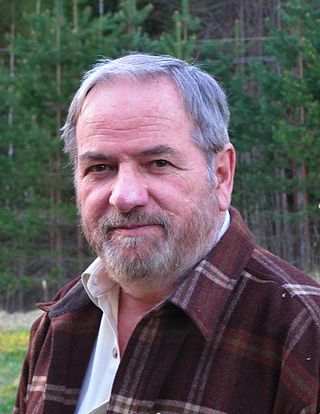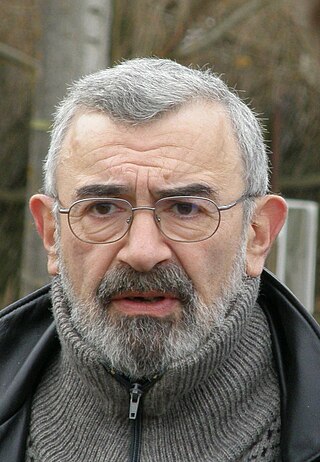Related Research Articles
Semiotics is the systematic study of sign processes and the communication of meaning. In semiotics, a sign is defined as anything that communicates intentional and unintentional meaning or feelings to the sign's interpreter.
Biosemiotics is a field of semiotics and biology that studies the prelinguistic meaning-making, biological interpretation processes, production of signs and codes and communication processes in the biological realm.

Jakob Johann Freiherr von Uexküll was a Baltic German biologist who worked in the fields of muscular physiology and animal behaviour studies and was an influence on the cybernetics of life. However, his most notable contribution is the notion of Umwelt, used by semiotician Thomas Sebeok and philosopher Martin Heidegger. His works established biosemiotics as a field of research.

In the semiotic theories of Jakob von Uexküll and Thomas Sebeok, umwelt is the "biological foundations that lie at the very center of the study of both communication and signification in the human [and non-human] animal". The term is usually translated as "self-centered world". Uexküll theorised that organisms can have different umwelten, even though they share the same environment. The term umwelt, together with companion terms Umgebung and Innenwelt, have special relevance for cognitive philosophers, roboticists and cyberneticians because they offer a potential solution to the conundrum of the infinite regress of the Cartesian Theater.

Thomas Albert Sebeok was a Hungarian-born American polymath, semiotician, and linguist. As one of the founders of the biosemiotics field, he studied non-human and cross-species signaling and communication. He is also known for his work in the development of long-time nuclear waste warning messages, in which he worked with the Human Interference Task Force to create methods for keeping the inhabitants of Earth away from buried nuclear waste that will still be hazardous 10,000 or more years in the future.
The semiosphere is an idea in biosemiotic theory proposing that, contrary to ideas of nature determining sense and experience, the phenomenal world is a creative and logical structure of processes of semiosis where signs operate together to produce sense and experience.

Kalevi Kull is a biosemiotics professor at the University of Tartu, Estonia.

John Deely was an American philosopher and semiotician. He was a professor of philosophy at Saint Vincent College and Seminary in Latrobe, Pennsylvania. Prior to this, he held the Rudman Chair of Graduate Philosophy at the Center for Thomistic Studies, located at the University of St. Thomas (Houston).

Karl Kuno Thure Freiherr von Uexküll was a German scholar of psychosomatic medicine and biosemiotics. He developed the approach of his father, Jakob von Uexküll, in the study of living systems and applied it in medicine.
Martin Krampen was a leading German semiotician, semiotics Professor in Göttingen.
Phytosemiotics is a branch of biosemiotics that studies the sign processes in plants, or more broadly, the vegetative semiosis. Vegetative semiosis is a type of sign processes that occurs at cellular and tissue level, including cellular recognition, plant perception, plant signal transduction, intercellular communication, immunological processes, etc.
Giorgio Prodi was an Italian medical scientist, oncologist and semiotician.
International Association for Semiotic Studies is the major world organisation of semioticians, established in 1969.

Aleksei Turovski is an Estonian zoologist and ethologist, specialising in parasitology and zoosemiotics. In 1973, he graduated from Tartu University with a degree in zoology; since 1972 he's been working in the Tallinn Zoo. In 1976–2001, Turovski worked in the Estonian Marine Institute.

Jesper Hoffmeyer was a professor at the University of Copenhagen Institute of Biology, and a leading figure in the emerging field of biosemiotics. He was the president of the International Society for Biosemiotic Studies (ISBS) from 2005 to 2015, co-editor of the journal Biosemiotics and the Springer Book series in Biosemiotics. He authored the books Biosemiotics: An Examination into the Signs of Life and the Life of Signs and Signs of Meaning in the Universe and edited A Legacy for Living Systems: Gregory Bateson as Precursor to Biosemiotics.
Ecosemiotics is a branch of semiotics in its intersection with human ecology, ecological anthropology and ecocriticism. It studies sign processes in culture, which relate to other living beings, communities, and landscapes. Ecosemiotics also deals with sign-mediated aspects of ecosystems.
The following outline is provided as an overview of and topical guide to semiotics:
Copenhagen–Tartu school of biosemiotics is a loose network of scholars working within the discipline of biosemiotics at the University of Tartu and the University of Copenhagen.
The International Semiotics Institute is an international research institute, devoted to the study and dissemination of semiotics and interdisciplinary studies. Activities include research, publications, academic events, teaching, consultations, training and supervision, but also extra-academic projects focused on social progress and sustainability.

Susan Petrilli is an Italian semiotician, professor of philosophy and theory of languages at the University of Bari, Aldo Moro, Italy, and the seventh Thomas A. Sebeok Fellow of the Semiotic Society of America. She is also International Visiting Research Fellow at the School of Psychology, the University of Adelaide, South Australia.
References
- ↑ Maran, Timo; Martinelli, Dario; Turovski, Aleksei (eds.), 2011. Readings in Zoosemiotics. (Semiotics, Communication and Cognition 8.). Berlin: De Gruyter Mouton.
- ↑ Kull, Kalevi 2014. Zoosemiotics is the study of animal forms of knowing. Semiotica 198: 47–60.
- ↑ "Zoosemiotics". Thomas A. Sebeok. American Speech , Vol. 43, No. 2 (May, 1968), pp. 142-144
- ↑ Zoosemiotics: Juncture of Semiotics and the Biological Study of Behavior. Science 29 January 1965: Vol. 147 no. 3657 pp. 492-493
- ↑ Baer, Eugen. 1987. Thomas A. Sebeok's Doctrine of Signs, in Krampen, et al. (eds.) "Classics of Semiotics" Plenum Press. p. 187
- ↑ Martinelli, Dario. "Zoosemiotics" in Semiotics Encyclopedia Online. E.J. Pratt Library - Victoria University.